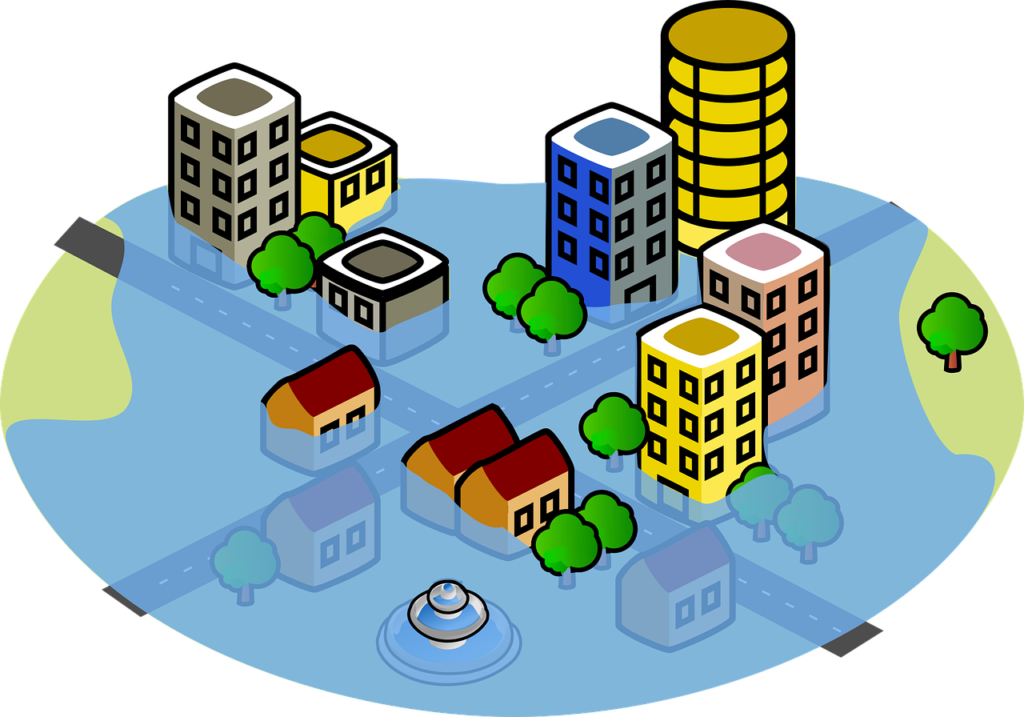Imagine being stunned by the sound of rushing water in the middle of the night. When you get out of bed, you discover a watery puddle on the floor beneath your feet. As soon as you realize your basement is flooding, panic sets in. What do you do to cleanup flooded basement? Who do you call for flooded basement cleanup?
Introduction
The worst nightmare of a homeowner may be dealing with a flooded basement. No matter what caused the damage—heavy rain, a burst pipe, or a sewage backup—it may be costly and extensive. However, you can reduce the damage and restore your basement to its pre-flood state with the appropriate equipment, information, and expert assistance.
From prevention to restoration, we will walk you through the process of cleaning up a flooded basement in this article. We will respond to frequently asked questions like “How can you prevent basement flooding in the future?” and “What should you do first when your basement floods?” So, whether you’re dealing with a crisis right now or just want to be ready for the next one, read on for advice from professionals on how to clean up a flooded basement ?
1. Safety First

Prioritizing your safety is the first and most important step in cleaning up a flooded basement. You must make sure that you and anyone else entering the flooded area are safe before you even consider beginning the cleanup process.
Turning off the Power in the basement is the first thing to do. Electricity and water do not mix, and any electrical equipment or cords that come into contact with the water run the risk of electrocuting someone. You can ask an electrician or your utility company for assistance if you’re unsure how to turn off the power.
The next step is to take precautions to avoid being exposed to any potentially harmful chemicals or bacteria that may be present in the water. To protect yourself from any contact with the water or the surrounding air, put on rubber gloves, water-resistant boots, and a mask or respirator.
It’s critical to ensure the safety of anyone else entering the basement in addition to your own. Don’t let anyone enter the flooded area without the necessary safety gear, and keep children and pets out of the area as well.
Never forget that safety should come first. Don’t take any unnecessary chances, and ask for help from a professional if you’re unsure of what to do.
2. Identify the Source of the Water

The next step is to determine the source of the water after you have made sure you are safe. Knowing where the water came from will help you choose the best cleanup strategy and avoid further flooding.
You may be able to clean up the water yourself if it is clean and came from a burst pipe or rain. However, it’s imperative to contact a specialist for assistance if the water is contaminated or the result of a sewage backup. Water that has been contaminated may contain pathogens and dangerous bacteria that are extremely dangerous to human health.
If you’re unsure of where the water is coming from, look around the basement for hints. A hissing noise or a sudden drop in water pressure are two indications that a pipe may have burst. By searching for cracks in the foundation or openings in window frames, you might be able to locate the source of the water if it is coming from the outside, such as from a heavy downpour.
Once you’ve determined where the water is coming from, take action to solve the problem. If a pipe has burst, turn off the water to the area and call a plumber. Consider installing a sump pump or fixing the drainage system around your home if it’s because of a drainage problem or a period of heavy rain.
Remember, if you’re dealing with contaminated water, don’t attempt to clean it up yourself. Call a professional water damage restoration company that specializes in sewage backup cleanup to ensure the safety of you and your family.
3. Remove Standing Water

It’s time to start removing the standing water now that you’ve taken the necessary safety precautions and located the source of the water. It’s critical to act quickly because the longer the water sits, the more harm it can do to your house and possessions.
Depending on how much water is present and the tools you have, you can remove the standing water using a variety of techniques. A common and efficient tool for draining water from a flooded basement is a wet-dry vacuum. Most hardware or home improvement stores rent out these vacuums.
Utilizing a sump pump, which is intended to remove water from the lowest point in your house, such as a basement, is an additional choice. A sump pump is an effective tool for averting further flooding and can be rented or purchased. When installing and using a sump pump, it’s crucial to carefully adhere to the manufacturer’s instructions.
If you have a lot of standing water, you might want to rent a water pump from a hardware store. These pumps are strong and can quickly drain your basement of a significant amount of water.
Regardless of the technique you select, make sure to put on safety gear like gloves and boots to prevent contact with bacteria and other water contaminants. Follow all safety instructions and keep electrical devices, such as wet-dry vacuums and sump pumps, away from water when using them.
Once you’ve taken out as much of the standing water as you can, use a mop or towels to soak up any moisture that’s left and completely dry the area. This will aid in preventing further harm to your house and possessions.
4. Dry Out the Area

It’s critical to completely dry out your basement after you remove any remaining standing water. Mold development and other forms of water damage can result from even a small amount of moisture that is still present.
The best way to dry out your basement is to increase airflow and ventilation. Open the windows and doors to let in fresh air and improve air circulation. Use fans to circulate the air and hasten the drying process. To maximize their effectiveness, place fans in key locations like corners or close to walls.
Using a dehumidifier is another efficient method of drying out the area. A dehumidifier can be a useful tool in preventing the growth of mold because it works by removing moisture from the air. Most home improvement stores offer dehumidifiers for sale or rent.
Additionally, it’s crucial to search for any concealed pockets of moisture that might not be readily apparent. Look for any areas with a lot of moisture or humidity using a moisture meter. Keep a close eye on surfaces like walls, ceilings, and floors because they might be more likely to retain moisture.
Remember to be patient during the drying process. It may take several days or even weeks to completely dry out your basement, depending on the severity of the flooding and the tools available to you. Be sure to continue monitoring the area for signs of moisture or mold growth even after it appears dry.
By taking the time to dry out your basement thoroughly, you can help prevent further damage and ensure that your home is safe and healthy.
5. Clean and Disinfect

The process of cleaning up after a flood must start with disinfecting and cleaning the area. It is time to clean and disinfect all surfaces to ensure a safe and healthy environment after all standing water has been eliminated and the area has dried.
Start by clearing away any mud or debris that might have amassed during the flooding. After removing any larger debris with a shovel or broom, clean the walls, floors, and other surfaces with a disinfectant solution. To protect yourself from harmful bacteria or chemicals, make sure to wear gloves and other protective gear.
Make sure the disinfectant solution you select is suitable for the kind of water damage you are dealing with. Use a disinfectant solution made for that kind of water damage if the water was contaminated or came from a sewage backup. You can also combine bleach and water, but pay close attention to the directions on the bleach bottle.
All surfaces should be treated with the disinfectant solution, which should then be rinsed off with clean water. Depending on the surface you’re cleaning, you can apply the solution with a mop, a sponge, or a spray bottle. After disinfecting and cleaning all surfaces, properly dispose of any contaminated materials.
It’s also essential to sanitize any items that came in contact with the water. This includes furniture, clothing, and other personal belongings. Depending on the severity of the water damage, you may need to dispose of some items completely. For items that can be salvaged, use a disinfectant solution to sanitize them thoroughly.
By following these steps, you can ensure that the area is clean and safe to inhabit after a flood.
6. Prevent Future Flooding

Preventing future flooding in your basement is essential to avoid the stress, expense, and damage caused by water damage. Here are some tips to help you prevent future flooding:
- Install a sump pump: A sump pump can help prevent flooding by automatically pumping water out of your basement. Make sure to have a backup power source for the sump pump in case of a power outage.
- Seal cracks in the foundation: Cracks in the foundation can allow water to seep into your basement. Seal any cracks in the foundation and make sure that your home’s drainage system is functioning correctly.
- Redirect rainwater: Make sure that your home’s gutters and downspouts are in good condition and that they direct rainwater away from your home’s foundation. Consider adding extensions to downspouts to move water further away from your home.
- Regular maintenance and inspections: Regular maintenance of your home’s plumbing, roof, and foundation can help you identify and fix any potential issues before they become major problems. It’s also a good idea to have your home inspected by a professional to identify any potential risks.
By taking these preventative measures, you can reduce the risk of future flooding in your basement and protect your home from water damage.
7. Call a Professional

In some circumstances, especially when the water is contaminated or the damage is severe, it is imperative to call for professional assistance. Professional flood cleanup services are equipped with the knowledge and know-how to guarantee that the area is thoroughly cleaned and sanitized. Additionally, they can find and address any underlying problems that might have contributed to the flooding in the first place.
Additionally, water damage restoration specialists have access to specialized tools like industrial-grade dehumidifiers and air movers that can speed up the drying process and stop the growth of mold and mildew in the affected area. They can also assist you in making a claim and obtaining the coverage you require for the damages by working with your insurance provider.
If you’re dealing with a sewage backup cleanup, it’s especially important to call a professional as the water may be contaminated with harmful bacteria and pathogens. They will have the proper protective gear to safely remove the contaminated water and materials and properly disinfect the area.
In summary, if you’re not confident in your ability to clean up a flooded basement, or if the water is contaminated, calling a professional is the safest and most effective option. It can help prevent further damage and ensure that the area is properly cleaned and disinfected.
FAQs
Preventing future flooding in your basement involves taking several steps to keep water out and minimize the risk of damage. Some preventative measures include installing a sump pump, sealing any cracks in your foundation, redirecting rainwater away from your home, and maintaining proper drainage around your property. Regular maintenance and inspections of your plumbing and foundation can also help you identify and address any potential issues before they become major problems.
If the water in your basement is contaminated, it’s important to avoid contact with the water and call a professional restoration company for help. Attempting to clean up contaminated water on your own can be dangerous and may lead to exposure to harmful bacteria or chemicals. A certified restoration company has the expertise and equipment needed to safely and effectively clean up the water and prevent further damage.
Mold can begin to grow within 24 to 48 hours after a flood. The growth of mold can cause significant damage to your property and pose a health risk to you and your family. Therefore, it’s crucial to dry out the area thoroughly and quickly after a flood to prevent the growth of mold.
Cleaning up a flooded basement on your own is possible if the water is clean and the damage is minimal. However, if the water is contaminated or if the damage is extensive, it’s best to call a professional restoration company for help. Attempting to clean up contaminated water on your own can be dangerous, and improper cleanup can lead to mold growth and other long-term damage.
The cost of cleaning up a flooded basement can vary depending on the extent of the damage and the services needed. On average, homeowners can expect to pay anywhere from $1,000 to $10,000 for cleanup and restoration services. It’s important to note that if the water is contaminated or if there is significant damage, the cost may be higher. Homeowners may also want to check with their insurance provider to see if their policy covers the cost of water damage restoration services.
Conclusion
We hope that this guide provided by the Basement Savvy team has been helpful in addressing any concerns you may have had about cleaning up a flooded basement. It’s important to prioritize safety throughout the process and to identify the source of the water to determine the appropriate cleanup method. Removing standing water and drying out the area are critical steps in preventing further damage, and cleaning and disinfecting are crucial for maintaining a safe and healthy living space.
Remember, prevention is key when it comes to avoiding future flooding in your basement. Taking steps such as installing a sump pump and redirecting rainwater away from your home can help minimize the risk of flooding. Regular maintenance and inspections can also help you identify and address any potential issues before they become major problems.
If you’re not comfortable with the cleanup process, or if the water is contaminated, it’s important to call a professional for help. A certified restoration company can provide the expertise and equipment needed to safely and effectively clean up the water and prevent future damage.
Thank you for taking the time to read this guide, and we hope it has been informative and helpful. Remember, the Basement Savvy team is always here to help you with any basement-related issues you may encounter. Stay safe, and best of luck in your cleanup efforts!
Image Credits @ Pixabay

